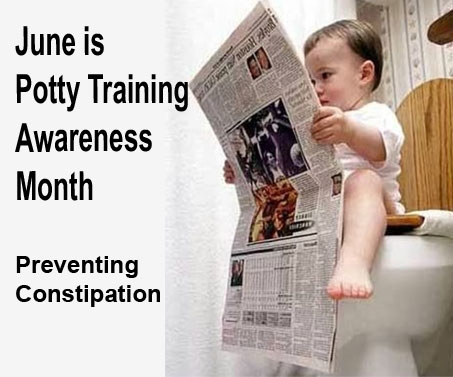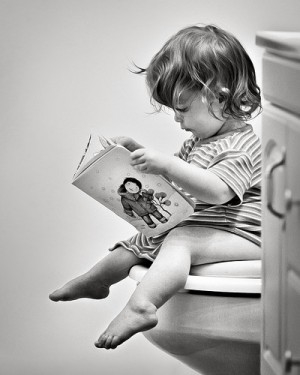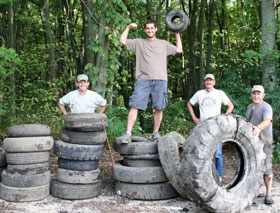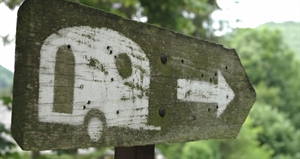Potty Training Awareness Month on June, 2025: Potty training advice?
June, 2025 is Potty Training Awareness Month 2025. Dietitians Online Blog: Potty Training Awareness Month Preventing ... June is Potty Training

Potty training is a rite of passage that all toddlers (and their parents) must go through. First you need to make you that both your toddler and you are ready to begin. Your toddler should be at least 2 years old, and be able to do such things as walk from room to room, raise and lower his or her own pants, sit independently, and follow a few one-step commands. Children also should have some awareness of and be able to communicate the need to urinate. You also need to be ready to provide consist support to your toddler as he or she learns to use the toilet. Your home life also should be fairly stable at this time (e.g., not in the process of moving or divorce.) Now you know that all parties are ready, here are some tips to help you both survive the process. They are called the 7 Ps, no pun intended.
1. Parent modeling. Frequently allow your child to go with either you or your spouse to the bathroom. Like almost anything else, young children first learn by observing and mimicking mom and dad’s behavior.
2. Potty chair. Give your child a chance to get used to and comfortable with the potty chair. Set it out and let your child sit on it, name it, put stickers on it, and decide (within reason) where to put it i.e. in front of the toilet or by the sink.
3. Practice. Let your child practice using the potty chair. This practice should be "play" practice, with clothes on. The next part may be difficult for some dads, but it’s only temporary. In the beginning, boys should be trained to sit on the potty chair or the toilet, for two reasons. First, sitting encourages bowel movements and so you might get a “twofer,” which is a bowel movement and urination during the same sitting. Second, sitting will help avoid what one might call the “garden hose” effect. Untrained boys have not yet had to stand, urinate, and aim all at the same time and may (will) accidentally spray the room (missing the potty or the toilet). Later, when toilet training is well established, they can stand.
4. Pull-ups. Unfortunately for your child (but fortunately for your budget), to make the program work, your child must go “cold turkey” on Pull-ups, except at bedtime. The reason for this approach is simple: Pull-ups are actually wearable toilets, and your child is unlikely to see much need for using the one in your home when he or she can much more easily use the one he or she is wearing.
5. Prompting: You will need to prompt your child to go to the bathroom and sit for a few minutes multiple times a day. Tell, them when they need to sit on the potty chair. Don’t ask if they need to go potty. The answer will invariably be “no” even as they do the ‘gotta potty’ dance in before your very eyes and a huge puddle forms on the floor at your very feet.
6. Praise. Praise you child for all correct toileting behaviors, Not just when he or she produces a poo-poo or a pee-pee but every time your child does any toileting behavior correctly – pulls down his or her pants, sits on the potty, whatever – be sure to praise him or her. Do this even when your child is having more accidents than successes. Remember, as children enter into the training phase, the training is likely to be way more important to you than it is to them. But if they get the idea that pooping and peeing into the potty is a way for them to get their names in lights, the importance of training will quickly increase for them, along with their cooperation. You can take this a step further and use rewards. One method is to wrap little items – stickers, tiny toys, beads, gum, etc. – in tin foil and put them in jar near the bathroom. When the child achieves a success at any level, he or she gets to grab one prize (not one handful) from the jar. Praise and rewards make the training experience fulfilling, and make it more likely that children will repeat the positive toilet behaviors.
7. Postpone. Here in P #7 we have some really good news. You can always postpone. You can always put them back in Pampers or Pull-ups, declare a moratorium on any discussion about toileting for a few weeks or even months, and then start again. They will ultimately be motivated to be trained, possibly by something other than your prompting. For example, the rules of social life in childhood weigh heavily against toileting accidents in school-aged kids. So the point of P #7 is that if training is going badly, for whatever reason, you can use the time-honored method for winning a war that is being lost – declare victory and retreat.
For more on potty training and other parenting issues, visit our website at www.parenting.org
Counselor C.L.
Boys Town National Hotline
1-800-448-3000

Help potty training a 27 months old girl?
Potty training is a rite of passage that all toddlers (and their parents) must go through. First you need to make you that both your toddler and you are ready to begin. Your toddler should be at least 2 years old, and be able to do such things as walk from room to room, raise and lower his or her own pants, sit independently, and follow a few one-step commands. Children also should have some awareness of and be able to communicate the need to urinate. You also need to be ready to provide consist support to your toddler as he or she learns to use the toilet. Your home life also should be fairly stable at this time (e.g., not in the process of moving or divorce.) Now you know that all parties are ready, here are some tips to help you both survive the process. They are called the 7 Ps, no pun intended.
1. Parent modeling. Frequently allow your child to go with either you or your spouse to the bathroom. Like almost anything else, young children first learn by observing and mimicking mom and dad’s behavior.
2. Potty chair. Give your child a chance to get used to and comfortable with the potty chair. Set it out and let your child sit on it, name it, put stickers on it, and decide (within reason) where to put it i.e. in front of the toilet or by the sink.
3. Practice. Let your child practice using the potty chair. This practice should be "play" practice, with clothes on. The next part may be difficult for some dads, but it’s only temporary. In the beginning, boys should be trained to sit on the potty chair or the toilet, for two reasons. First, sitting encourages bowel movements and so you might get a “twofer,” which is a bowel movement and urination during the same sitting. Second, sitting will help avoid what one might call the “garden hose” effect. Untrained boys have not yet had to stand, urinate, and aim all at the same time and may (will) accidentally spray the room (missing the potty or the toilet). Later, when toilet training is well established, they can stand.
4. Pull-ups. Unfortunately for your child (but fortunately for your budget), to make the program work, your child must go “cold turkey” on Pull-ups, except at bedtime. The reason for this approach is simple: Pull-ups are actually wearable toilets, and your child is unlikely to see much need for using the one in your home when he or she can much more easily use the one he or she is wearing.
5. Prompting: You will need to prompt your child to go to the bathroom and sit for a few minutes multiple times a day. Tell, them when they need to sit on the potty chair. Don’t ask if they need to go potty. The answer will invariably be “no” even as they do the ‘gotta potty’ dance in before your very eyes and a huge puddle forms on the floor at your very feet.
6. Praise. Praise you child for all correct toileting behaviors, Not just when he or she produces a poo-poo or a pee-pee but every time your child does any toileting behavior correctly – pulls down his or her pants, sits on the potty, whatever – be sure to praise him or her. Do this even when your child is having more accidents than successes. Remember, as children enter into the training phase, the training is likely to be way more important to you than it is to them. But if they get the idea that pooping and peeing into the potty is a way for them to get their names in lights, the importance of training will quickly increase for them, along with their cooperation. You can take this a step further and use rewards. One method is to wrap little items – stickers, tiny toys, beads, gum, etc. – in tin foil and put them in jar near the bathroom. When the child achieves a success at any level, he or she gets to grab one prize (not one handful) from the jar. Praise and rewards make the training experience fulfilling, and make it more likely that children will repeat the positive toilet behaviors.
7. Postpone. Here in P #7 we have some really good news. You can always postpone. You can always put them back in Pampers or Pull-ups, declare a moratorium on any discussion about toileting for a few weeks or even months, and then start again. They will ultimately be motivated to be trained, possibly by something other than your prompting. For example, the rules of social life in childhood weigh heavily against toileting accidents in school-aged kids. In fact, research shows that having an accident in school is the third greatest child fear, behind the death of a parent and going blind. (And I know that high school kids frown on their peers who wear Pampers or Pull-ups.) So the point of P #7 is that if training is going badly, for whatever reason, you can use the time-honored method for winning a war that is being lost – declare victory and retreat.
For more on potty training and other parenting issues, visit our website at www.parenting.org
Counselor C.L.
Boys Town National Hotline
1-800-448-3000

Potty Training?
Children are most likely to potty train when they start 6-12 months old and finish by age two, or else for a boy start at 3 to 3 1/2 years old. However, I strongly believe that a child is never too young to start learning about the toilet, even if they can't be realistically expected to complete training in a short period of time. If you do nothing else this year, set a good toileting example and help him retain an awareness of the feeling of wet.
tips:
1) example: take him to the bathroom when you go and teach him all about it, let him know he gets to do this someday too. He learns the importance of taking time to go to the toilet regularly through the day, he avoids developing fears of the toilet and flushing. It makes toilet learning as natural as learning how to walk instead of something stressful suddenly thrust on him at age 3.
2) teach him an awareness of how to voluntarily release pee.
The best time for him to try sitting on the potty is very first thing in the morning (get a baby bjorn or Ikea style since he is young and a boy). He will usually have a big pee in just a few minutes after waking. Celebrate, say "you're peeing" just as he does it. Soon, just sitting on the toilet will cue him to pee. Then when he has a desire to become trained it will be soooo much easier for him.
3)for a toddler (he'll soon be one) it is CRUCIAL to give him choice in the whole training thing or you might actually slow down his potty training process. When you are actively training, possible choices you could give him could be "do you want to try and get a sticker or not try?", do you want to try in the bathroom, or in the kitchen? do you want to try now or after a story?, do you want to wear a diaper or underpants this morning? etc. He is probably old enough to understand choices even if he isn't verbal yet, adjust for whatever age he is when you reach this point. He might not become fully trained right away, but everytime he pees/poos on the toilet, you save a diaper and keep him cleaner!
3) when he does learn how to voluntarily release pee, offer "pottytunities" throughout the day (after waking, after eating, before bath/bed, before going out, when returning home, etc). Make it fun, be relaxed about it. If he says no, then respect that, wait awhile, just keep offering again like you would green beans. He'll say yes when he is ready.
4) give him cloth diapers/training pants occasionally so he can learn the feeling of wet, practice voluntary control of his muscles, and unlearn the cue to pee/poo only in diapers.











